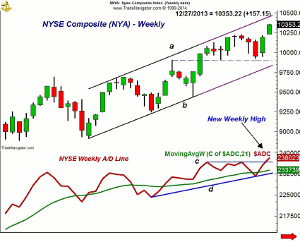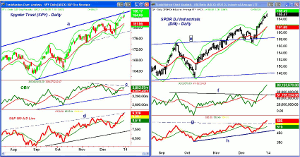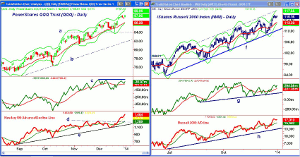As the stock market grinds ever higher, it is getting more difficult to find bears on Wall Street, which is a good reason to be more risk averse, counsels MoneyShow’s Tom Aspray.
A new trading year starts with the major market averages starting the New Year very close to the 2013 highs. The relentless rally in 2013 has had analysts scrambling all year to raise their yearly forecasts. In December of 2013, the average S&P 500 target was 1534, which was 17% below the actual closing high.
Forecasting the S&P 500’s closing price a year in advance is no easy task and is not consistent with my method of analysis. The leading action of the NYSE Advance/Decline last December favored double-digit gains in 2013 as it signaled that the bull market was still intact. The market internals continued to make new highs, but for me there was no way to tell whether it would be a 10% or a 30% yearly gain.
Wall Street strategists had a year-long race to see who could raise their forecasts the fastest. For example, JP Morgan’s famous bull Tom Lee started with a forecast of 1580, which meant a 10% gain. By last July, he had raised his forecast to 1775 and then to 1825.
Mr. Lee’s December 2013 forecast for 2014 is now at 2075, which implies a 12% gain from the 2013 close. In the past, this type of behavior has eventually led to sharp market corrections.
The bullish frenzy also hit the individual investor at the end of 2013 as the bullish percentage according to AAII rose to over 55% last week with the bearish percentage dropping to a two-year low. For now, the bullish euphoria appears to have peaked as the first reading of 2014 shows that the bullish% has now dropped back to just over 43%. A recent review of the financial newsletter writers showed that over 59% were bullish.
Clearly, it is becoming more difficult to find someone who is bearish on the stock market, which in my opinion, is good reason to be risk adverse when doing new buying. A close look at both the intermediate and short-term technical outlook should help one better plan one’s strategy for 2014.
The weekly chart of the NYSE Composite shows the strong close last week with the upper boundary of the trading channel, line a, now at 10,461. This is a mere 60 points above the 2013 close and the projected pivot high for the 1st quarter is at 11,048. This is 6% above the 2013 close.
It was more important that the weekly NYSE Advance/Decline also made a new high last week therefore overcoming the negative divergence (line c) from October and November. This is a bullish sign for 2014 but does not rule a sharp correction such as what we saw in 2012.
In early December, I was looking for the stock market to correct going into the end of the year. I thought then that the best strategy was for investors to concentrate on individual stocks and sectors, not the market averages.
The daily analysis discussed below suggests that new investors in particular should not get caught up in the early 2014 bullish euphoria by chasing the market averages or individual stocks. Better entry points will emerge in the first quarter of 2014, so your strategy should focus on the entry and the risk of each position, not the year-to-year performance.
Chart Analysis: The daily chart of the Spyder Trust (SPY) shows that it is close to the upper boundary of the trading channel that goes back to the May 2013 highs.
- The projected monthly pivot resistance for January is at $189.60, which is 2.6% above current levels.
- The rising 20-day EMA is at $181.56 and a pullback to this level would not be surprising.
- There is more important support in the $178 area, which is 3.6% lower.
- The S&P 500 A/D line did form a divergence in late November but it moved to new highs last Thursday and is testing resistance at line d.
The SPDR Dow Industrials (DIA) is up 5.3% after testing the daily starc- band on December 13.
- There is next resistance at $166.47 and the daily starc+ band with the weekly at $167.36.
- The monthly projected pivot resistance for January is at $171.12.
- The daily OBV shows an impressive breakout to new highs as the resistance at line f was overcome.
- The Dow Industrials A/D line also moved above its resistance (line g) last week confirming the price action.
- The monthly pivot is at $162.68 with the 20-day EMA at $161.69.
- The quarterly pivot and more critical support is now at $159.26.
NEXT PAGE: 2 More ETFs Moving Higher
|pagebreak|
The PowerShares QQQ Trust (QQQ) moved above last Friday’s high on Tuesday and the daily starc+ band is now at $89.06.
- The weekly starc+ band is at $89.06 with the monthly projected pivot resistance at $90.57.
- The daily OBV has turned up from its WMA but is still below resistance at line c as it has not confirmed the new highs.
- The weekly OBV (not shown) has made a new high.
- The A/D line is leading prices higher and this is a bullish sign.
- There is minor support now in the $86-$86.50 area with the monthly projected low at $85.35.
The iShares Russell 2000 Index (IWM) made a new all-time high last week at $115.97 and did not make new highs on Tuesday.
- The daily starc+ band is now at $117.55 with the weekly at $119.24.
- For January, the projected pivot resistance is at $120.20.
- The OBV is above its WMA but is still lagging the price action as it is well below the October highs.
- The weekly OBV (not shown) has also not yet confirmed the new highs.
- The daily Russell 2000 A/D line made new highs last week and is well above its rising WMA.
- The rising 20-day EMA is at $113.20, which is 1.9% below Tuesday’s close.
- The quarterly pivot and more important support is now at $111.44.
What It Means: The high level of bullish sentiment amongst both the professionals and individual investors continues to favor a cautious buying strategy. The Total Put/Call ratio hit a multi-year low in December consistent with the low level of bearish sentiment. Sentiment warnings are often quite early but still should not be ignored.
The most bullish scenario would be for a quick 2-3% drop that could temper the bullish sentiment and set the stage for further new highs. The jobs data next week could be a catalyst.
The lagging action of the daily OBV analysis should also be monitored as it could move into the short-term sell mode ahead of prices. There are many stocks, as well as ETFs, that have completed their bottom formations over the past two weeks.
They now need a decent correction to set up a good buying opportunity as these new buy candidates could easily drop back to their rising 20-day EMAs.
How to Profit: No new recommendation for now.





















